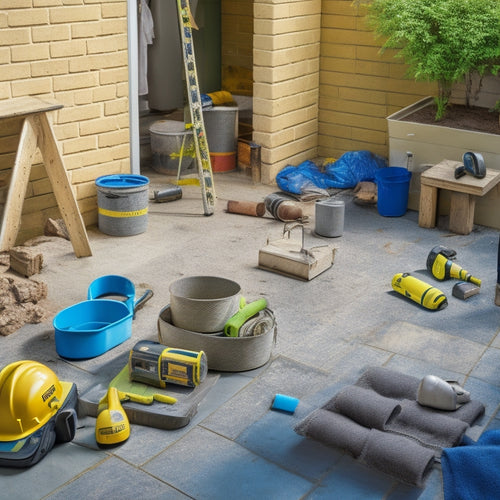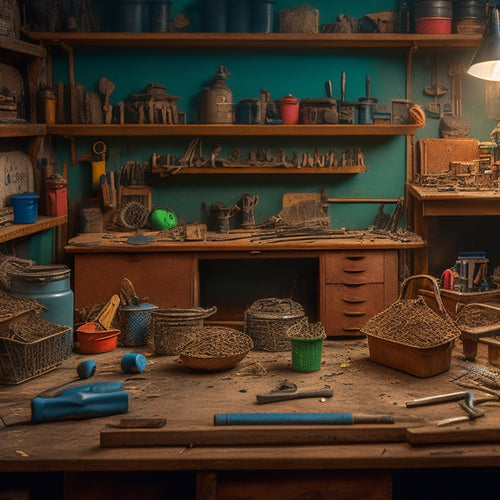
3 Tips for Organizing Home Renovation Tool Storage
Share
When organizing your home renovation tool storage, start by evaluating your tool collection, categorizing items by type, and noting their condition and maintenance needs. Next, maximize your storage space by utilizing vertical options, multi-functional furniture, and compact containers to keep tools accessible and visible. Finally, label each bin or container with its contents and consider a color-coding system to quickly identify categories - and don't forget to regularly update your labels as your tool inventory changes. By implementing these strategies, you'll be well on your way to a more efficient workspace, and there's even more you can do to take your organization to the next level.
Key Takeaways
• Gather all tools from the workspace and categorize them by type, such as power tools, hand tools, and fasteners, to create a comprehensive inventory.
• Utilize vertical storage options like shelves, hooks, or pegboards to maximize storage space and keep frequently used tools easily accessible.
• Label each tool bin or container with its contents and use a color-coding system for efficient categorization, ensuring consistency across all storage solutions.
Assessing Your Tool Collection
Take inventory of your tools by gathering them from every nook and cranny of your workspace, garage, or storage areas to get a clear picture of what you're working with. This is the first step in organizing your home renovation tool storage.
As you collect your tools, categorize them by type, such as power tools, hand tools, and fasteners. Create a list or spreadsheet to keep track of your tool inventory, noting the tool's name, condition, and any maintenance or repair needs.
Assess the tool condition by inspecting each item for damage, rust, or wear. Identify tools that need sharpening, cleaning, or replacement. This will help you prioritize which tools to use first and which ones to store or replace.
Make notes on any tools that are missing or need to be purchased. Having a thorough tool inventory will help you stay organized, guarantee you have the right tools for the job, and prevent last-minute trips to the hardware store.
Maximizing Storage Space Efficiently
Now that you've taken stock of your tool collection, it's time to think strategically about how to store them in a way that makes the most of your available space. You want to create a system that's efficient, easy to navigate, and keeps your tools within reach.
To maximize your storage space, consider the following:
-
Vertical storage: Install shelves, hooks, or a pegboard on your walls to take advantage of often-wasted vertical space. This will help keep your floors and countertops clear and make the most of your room's dimensions.
-
Multi-functional furniture: Invest in storage units that serve multiple purposes, such as a workbench with built-in cabinets or a storage ottoman with a removable top.
-
Compact containers: Use bins, baskets, and containers specifically designed for tool storage to keep smaller items organized and out of the way.
Labeling and Categorizing Tools
By categorizing and labeling your tools, you'll create a system that allows you to quickly locate the exact tool you need, saving time and reducing frustration in the process. This is especially important when working on a home renovation project, where every minute counts. To get started, sort your tools into categories, such as hand tools, power tools, and fasteners. Then, label each tool bin or container with its contents and a corresponding color code.
| Tool Category | Color Code |
|---|---|
| Hand Tools | Red |
| Power Tools | Blue |
| Fasteners | Yellow |
| Measuring Tools | Green |
Frequently Asked Questions
How Often Should I Clean and Maintain My Tool Storage System?
You're wondering how often to clean and maintain your tool storage system.
Set a cleaning schedule to tackle clutter every 2-3 months, and dedicate 30 minutes each week to tidying up.
For maintenance tips, check expiration dates on supplies, sharpen dull blades, and lubricate moving parts.
Can I Store Tools in an Unheated Garage or Shed?
You're wondering if you can store tools in an unheated garage or shed. Well, it's doable, but you'll need to prioritize tool protection.
Climate impact plays a significant role here. Extreme temperatures, humidity, and moisture can damage your tools.
Consider using waterproof containers, silica gel packets, and rust-resistant coatings to safeguard your equipment.
Just remember to check on them regularly to guarantee they're in good condition.
Are There Any Specific Tools That Require Special Storage Considerations?
When it comes to storing your tools, you'll want to give special attention to specialty tools that require unique storage considerations.
For instance, lithium-ion batteries need protection from extreme temperatures, so you'll want to store them in a climate-controlled area.
Similarly, certain power tools, like circular saws, require specific storage solutions to prevent damage.
How Do I Deal With Tool Storage for Oddly Shaped or Oversized Items?
You're stuck with a jigsaw that's as awkward as a teenager at a family reunion, and a ladder that's as unwieldy as a newborn giraffe.
Don't worry, you're not alone. For those oddly shaped or oversized items, consider custom shelving that's tailored to their unique dimensions.
Make the most of your space with vertical storage solutions, like wall-mounted racks or ceiling-hung shelves.
This way, you'll be able to store your tools efficiently and keep your workspace clutter-free.
Are There Any Safety Concerns I Should Consider When Storing Tools?
When storing tools, you should be mindful of tool safety to avoid storage hazards.
You'll want to keep heavy tools on lower shelves to prevent them from falling and causing injury.
Also, store sharp objects in a secure, hard-to-reach place to prevent accidents.
Additionally, make certain you have a clear path to your tools to avoid tripping hazards.
Conclusion
As you put the finishing touches on your newly organized tool storage, remember that a well-maintained system is like a well-oiled machine - it keeps running smoothly only with regular tune-ups.
Just as a car needs regular oil changes to perform at its best, your tool storage needs occasional reassessment to guarantee it remains efficient and effective.
By staying on top of your tool collection, you'll avoid the frustration of lost time and energy, and instead, be ready to tackle your next home renovation project with confidence.
Related Posts
-

7 Patio Safety Tips for DIY Renovation Projects
As you begin your DIY patio renovation project, prioritize safety by evaluating the worksite for tripping hazards and...
-

Why Do Cinder Block Wall Renovations Cost So Much
You're likely surprised by the high cost estimate for your cinder block wall renovation project, but it's driven by s...
-

Why Tool Exchange Matters in Home Renovation
You rely on a well-maintained tool belt to complete home renovation projects efficiently, and having access to the ri...


